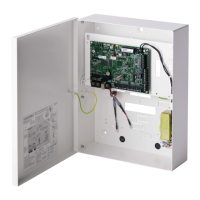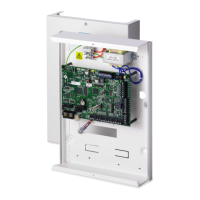Do you have a question about the Vanderbilt SPC6350 and is the answer not in the manual?
| Brand | Vanderbilt |
|---|---|
| Model | SPC6350 |
| Category | Power Supply |
| Language | English |
Outlines essential safety precautions before installing and operating the device.
Lists relevant European directives (EMC, Low Voltage, R&TTE) and compliance standards.
Details technical specifications for the SPC4000, covering areas, PINs, zones, outputs, interfaces, and power.
Details the procedure for opening the G2 housing and mounting it to a wall, including screw recommendations.
Explains how to open the G3 housing and mount it, mentioning the placement of controller and expanders.
Describes how to install a back tamper kit for enhanced tamper protection and mounting the wall fixing plate.
Details battery installation for EN50131 compliance, including securing methods and battery placement.
Covers the mounting of the G5 housing, including opening it and placing the controller and PSU.
Describes the SPCP355.300 Smart PSU, a power supply with an expander, its backup batteries, and outputs.
Details the controller hardware for SPC42xx, 43xx, 53xx, and 63xx models, including on-board zones and optional wireless modules.
Details the hardware of SPC5350 and 6350 controllers, including optional modules, status LEDs, and reset button.
Details how to wire the X-BUS interface for expander connections, supporting loop and spur configurations.
Details powering the system from battery only, including minimum voltage requirements and deep discharge protection.
Describes the LCD keypad, its interface capabilities for engineers and users, and its features like tamper switch and display.
Describes the Comfort keypad models (SPCK620/623), their features, and optional enhancements.
Explains the two programming modes: Full Engineer and Soft Engineer, and their respective functionalities.
Details the default engineer PIN ('1111'), its modification for Grade 3, and PIN digit requirements.
Details configuring outputs, including door sounder, interlock, and door timers.
Covers configuring communication settings, including serial ports, Ethernet, modems, and central stations.
Covers various system tests, including bell tests, walk tests, zone monitoring, and output tests.
Guides on changing the Engineer PIN, including PIN generation and saving.
Covers user management, allowing users with appropriate rights to add, edit, or delete users.
Details connecting to the panel via USB, including driver installation and configuring the connection on Windows XP.
Explains how to log into the browser interface after establishing an Ethernet or USB link, including entering the IP address and credentials.
Introduces the SPC Home page with tabs for System Summary, Alarms, and Video.
Provides an overview of panel status, including system, power, X-BUS, and communications.
Details how to view the status and summary of SPC components, with performable actions like Restore Alerts and Refresh.
Describes viewing X-Bus status for keypads, expanders, and door controllers, showing their online/offline status.
Displays current status of PSUs and their outputs, including mains, battery, load, and fuse conditions.
Guides on viewing zones, including all zones, X-Bus zones, and wireless zones.
Details viewing door status, including door ID, zone, area, DPS, DRS, status, and door mode.
Displays the status of each ATS configured on the system, including registration ID, status, and event queue information.
Shows system alert status, including input, status, and performable actions like Restore, Inhibit, and Isolate.
Covers user management, including maximum numbers of users, profiles, devices, and adding/editing users.
Covers managing user profiles, including adding, editing, and deleting them.
Explains configuring SMS alerts and control, including SMS Authentication, events, and commands.
Covers system configuration, including inputs, outputs, doors, areas, calendars, and communications.
Details configuring controller inputs and outputs, including editing inputs and outputs.
Covers X-BUS configuration, including expanders, keypads, door controllers, cable maps, and settings.
Covers wireless sensor detection, enrollment, and managing WPAs, including status and signal strength.
Describes system options related to restriction, code restore, offline tamper, keyfob restore, and audio expander LED.
Provides an overview of timer defaults and descriptions, covering audible settings, confirmation, dialer delay, and setting authorization.
Covers configuring communication settings, including networking services, Ethernet, modems, serial ports, and FlexC.
Introduces the SPC Flexible Secure Communications Protocol (FlexC) for IP-based Alarm Transmission Systems.
Provides instructions for using the Fast Programmer for uploading/downloading configuration files and upgrading firmware.









